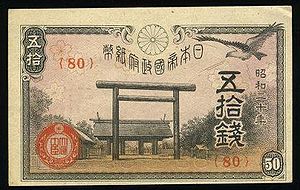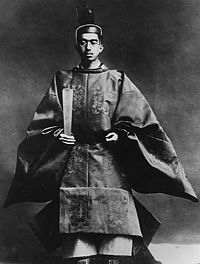
State Shinto
Encyclopedia

State religion
A state religion is a religious body or creed officially endorsed by the state...
of the Empire of Japan
Empire of Japan
The Empire of Japan is the name of the state of Japan that existed from the Meiji Restoration on 3 January 1868 to the enactment of the post-World War II Constitution of...
, although it did not exist as a single institution and no "Shintō" was ever declared a state religion. The idea of "State Shinto" was never conceived of during the imperial era, but was first proposed in 1970 by the postwar religious scholar Shigeyoshi Murakami to classify those ideals, rituals and institutions that were created by the government to promote the divinity of the emperor
Arahitogami
is a Japanese word meaning a kami who is a human being.It first appears in Kojiki , but is assumed to have been used before this book....
and the uniqueness of Japan (kokutai
Kokutai
Kokutai is a politically loaded word in the Japanese language, translatable as "sovereign", "national identity; national essence; national character" or "national polity; body politic; national entity; basis for the Emperor's sovereignty; Japanese constitution". "Sovereign" is perhaps the most...
). Murakami's book proved to be one of the most popular books about religion in postwar Japanese history. While the concept has since been considered by scholars to be overreaching the actual scope of government interference in religion, the fact that government did interfere cannot be denied.
History
In the late Edo periodEdo period
The , or , is a division of Japanese history which was ruled by the shoguns of the Tokugawa family, running from 1603 to 1868. The political entity of this period was the Tokugawa shogunate....
, numerous scholars of kokugaku
Kokugaku
Kokugaku was a National revival, or, school of Japanese philology and philosophy originating during the Tokugawa period...
believed that Shintō could become a unifying agent to center the country around the Emperor while a process of modernization was undertaken. After the Meiji Restoration
Meiji Restoration
The , also known as the Meiji Ishin, Revolution, Reform or Renewal, was a chain of events that restored imperial rule to Japan in 1868...
, the new imperial government needed to rapidly modernize the politics and economy of Japan
Economy of Japan
The economy of Japan, a free market economy, is the third largest in the world after the United States and the People's Republic of China, and ahead of Germany at 4th...
, and the Meiji oligarchy
Meiji oligarchy
The Meiji oligarchy was the name used to describe the new ruling class of Meiji period Japan. In Japanese, the Meiji oligarchy is called the ....
felt that those goals could only be accomplished through a strong sense of national unity and cultural identity.
In 1868, the new Meiji government established a government bureau, the to oversee religious affairs and to administer the government-ordered separation of Buddhism from Shintō
Shinbutsu Bunri
The term in Japanese indicates the forbidding by law of the amalgamation of kami and buddhas made during the Meiji Restoration. It also indicates the effort made by the Japanese government to create a clear division between native kami beliefs and Buddhism on one side, and Buddhist temples and...
.
Establishment
In 1871, all Shintō shrines throughout Japan were declared to be property of the central government, were assigned an official rank within a hierarchy and received a subsidy for their upkeep. Shrines were divided into twelve levels with the Ise Shrine (dedicated to AmaterasuAmaterasu
, or is apart of the Japanese myth cycle and also a major deity of the Shinto religion. She is the goddess of the sun, but also of the universe. the name Amaterasu derived from Amateru meaning "shining in heaven." The meaning of her whole name, Amaterasu-ōmikami, is "the great August kami who...
, and thus symbolic of the legitimacy of the Imperial family) at the top.
Furthermore, all citizens were required to register as a parishioner of their local shrine, and each parishioner of a local shrine was automatically also a parishioner of the Ise Shrine. This was a major reverse from the Edo period
Edo period
The , or , is a division of Japanese history which was ruled by the shoguns of the Tokugawa family, running from 1603 to 1868. The political entity of this period was the Tokugawa shogunate....
, in which families were required to register with Buddhist temples, rather than Shintō shrines.

Kannushi
A , also called , is the person responsible for the maintenance of a Shinto shrine as well as for leading worship of a given kami. The characters for kannushi are sometimes also read jinshu with the same meaning....
officially became government employees. Thus, from a legal perspective, State Shintō was not a religion and its values came under the heading of moral instruction rather than religious teaching.
This concentrated on the more important shrines; folk Shintō practices were mostly left unmolested and various fringe Shintō movements dating from the Edo period were allowed to continue under the rubric Sect Shintō.
In 1890, the Imperial Rescript on Education
Imperial Rescript on Education
The ' was signed by Emperor Meiji of Japan on 30 October 1890 to articulate government policy on the guiding principles of education on the Empire of Japan...
was issued, and students were required to ritually recite its oath to "offer yourselves courageously to the State" as well as protect the Imperial family. The practice of emperor worship was further spread by distributing imperial portraits for esoteric veneration. All of these practices, used to fortify national solidarity through patriotic centralized observance at shrines, gave pre-war Japanese nationalism
Japanese nationalism
encompasses a broad range of ideas and sentiments harbored by the Japanese people over the last two centuries regarding their native country, its cultural nature, political form and historical destiny...
a tint of mysticism
Mysticism
Mysticism is the knowledge of, and especially the personal experience of, states of consciousness, i.e. levels of being, beyond normal human perception, including experience and even communion with a supreme being.-Classical origins:...
and cultural introversion.
Article 28 of the Constitution of the Empire of Japan
Meiji Constitution
The ', known informally as the ', was the organic law of the Japanese empire, in force from November 29, 1890 until May 2, 1947.-Outline:...
reaffirmed the privileged position of Shintō, but also guaranteed freedom of religion
Freedom of religion
Freedom of religion is a principle that supports the freedom of an individual or community, in public or private, to manifest religion or belief in teaching, practice, worship, and observance; the concept is generally recognized also to include the freedom to change religion or not to follow any...
“within limits not prejudicial to peace and order and not antagonistic to their duties as subjects”. In practice, this meant that religious groups were required to receive government approval and that their doctrine
Doctrine
Doctrine is a codification of beliefs or a body of teachings or instructions, taught principles or positions, as the body of teachings in a branch of knowledge or belief system...
s and ritual
Ritual
A ritual is a set of actions, performed mainly for their symbolic value. It may be prescribed by a religion or by the traditions of a community. The term usually excludes actions which are arbitrarily chosen by the performers....
s came under government scrutiny.
During World War II, the government used State Shintō to encourage patriotism and to support efforts towards militarism
Japanese militarism
refers to the ideology in the Empire of Japan that militarism should dominate the political and social life of the nation, and that the strength of the military is equal to the strength of a nation.-Rise of militarism :...
. Noted figures in government, including Kuniaki Koiso
Kuniaki Koiso
- Notes :...
, Heisuke Yanagawa
Heisuke Yanagawa
- Notes :...
, Kiichirō Hiranuma
Kiichiro Hiranuma
Baron was a prominent pre–World War II right-wing Japanese politician and the 35th Prime Minister of Japan from 5 January 1939 to 30 August 1939. The modern Japanese politician, Takeo Hiranuma, is his adopted son.- Early life :...
and Prince Kan'in Kotohito
Prince Kan'in Kotohito
, wasthe sixth head of a cadet branch the Japanese imperial family, and a career army officer who served as Chief of the Imperial Japanese Army General Staff from 1931 to 1940.-Early years:...
, participated in public rituals modeled after ancient ceremonies to foster a sense that supporting the war was a sacred duty.
State Shintō officially came to an end after the surrender of Japan
Surrender of Japan
The surrender of Japan in 1945 brought hostilities of World War II to a close. By the end of July 1945, the Imperial Japanese Navy was incapable of conducting operations and an Allied invasion of Japan was imminent...
.
Disestablishment
After Japan's defeat in World War IIWorld War II
World War II, or the Second World War , was a global conflict lasting from 1939 to 1945, involving most of the world's nations—including all of the great powers—eventually forming two opposing military alliances: the Allies and the Axis...
, the Supreme Commander of the Allied Powers
Supreme Commander of the Allied Powers
Supreme Commander of the Allied Powers was the title held by General Douglas MacArthur during the Occupation of Japan following World War II...
issued the Shinto Directive
Shinto Directive
After the Second World War during the Occupation of Japan by the United States Military it was generally understood by allied students of Japanese culture and religion that Shinto in the form it took leading up to and during the war was social propaganda and was being used as a tool of...
and ordered the separation of the government from religious affairs during the occupation of Japan, and separation of church and state
Separation of church and state
The concept of the separation of church and state refers to the distance in the relationship between organized religion and the nation state....
was incorporated into the 1947 Constitution of Japan
Constitution of Japan
The is the fundamental law of Japan. It was enacted on 3 May, 1947 as a new constitution for postwar Japan.-Outline:The constitution provides for a parliamentary system of government and guarantees certain fundamental rights...
.
On 1 January 1946, Emperor Shōwa issued a statement, sometimes referred to as the Ningen-sengen
Ningen-sengen
is an imperial rescript issued by the Emperor Shōwa as part of a New Year’s statement on January 1, 1946 at the request of the Supreme Commander of the Allied Powers...
, in which he quoted the Five Charter Oath
Five Charter Oath
The was promulgated at the enthronement of Emperor Meiji of Japan on 7 April 1868. The Oath outlined the main aims and the course of action to be followed during Emperor Meiji's reign, setting the legal stage for Japan's modernization...
of Emperor Meiji
Emperor Meiji
The or was the 122nd emperor of Japan according to the traditional order of succession, reigning from 3 February 1867 until his death...
and announced he was not an akitsumikami
Ningen-sengen
is an imperial rescript issued by the Emperor Shōwa as part of a New Year’s statement on January 1, 1946 at the request of the Supreme Commander of the Allied Powers...
(incarnation of a god).

